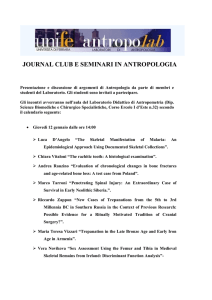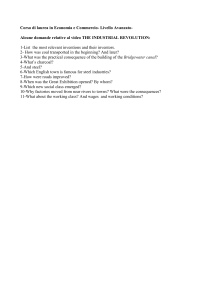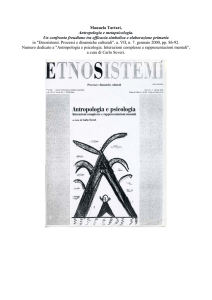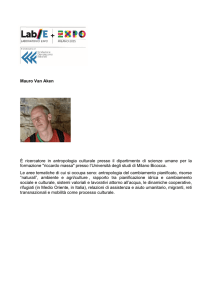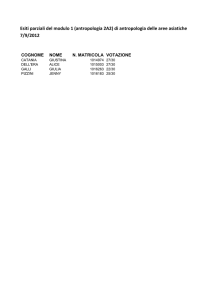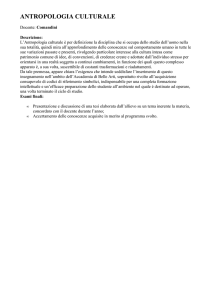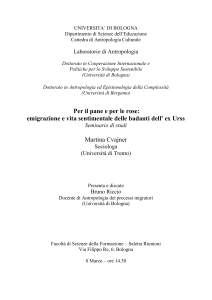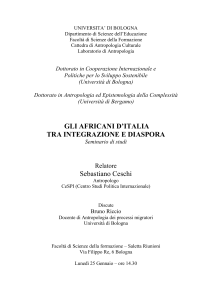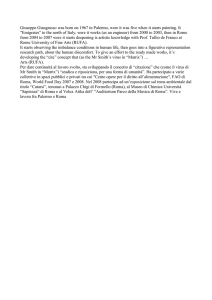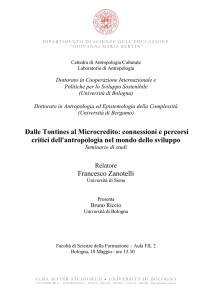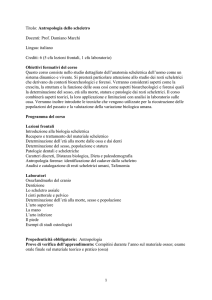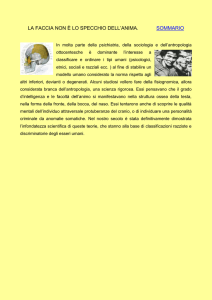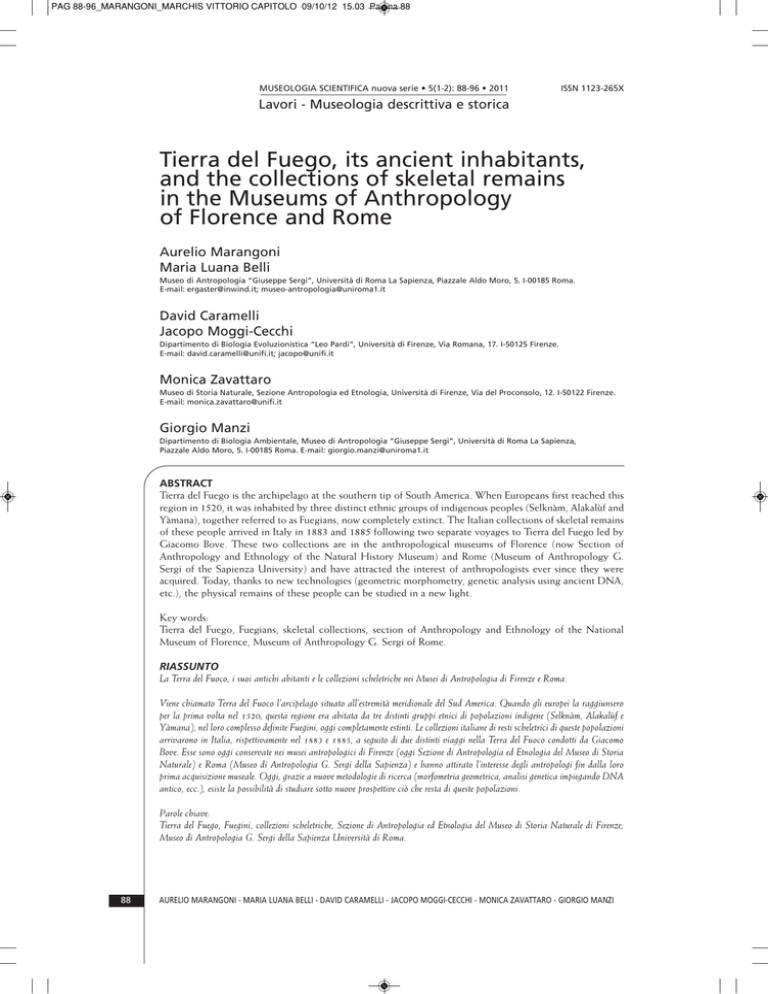
PAG 88-96_MARANGONI_MARCHIS VITTORIO CAPITOLO 09/10/12 15.03 Pagina 88
MUSEOLOGIA SCIENTIFICA nuova serie • 5(1-2): 88-96 • 2011
ISSN 1123-265X
Lavori - Museologia descrittiva e storica
Tierra del Fuego, its ancient inhabitants,
and the collections of skeletal remains
in the Museums of Anthropology
of Florence and Rome
Aurelio Marangoni
Maria Luana Belli
Museo di Antropologia “Giuseppe Sergi”, Università di Roma La Sapienza, Piazzale Aldo Moro, 5. I-00185 Roma.
E-mail: [email protected]; [email protected]
David Caramelli
Jacopo Moggi-Cecchi
Dipartimento di Biologia Evoluzionistica “Leo Pardi”, Università di Firenze, Via Romana, 17. I-50125 Firenze.
E-mail: [email protected]; [email protected]
Monica Zavattaro
Museo di Storia Naturale, Sezione Antropologia ed Etnologia, Università di Firenze, Via del Proconsolo, 12. I-50122 Firenze.
E-mail: [email protected]
Giorgio Manzi
Dipartimento di Biologia Ambientale, Museo di Antropologia “Giuseppe Sergi”, Università di Roma La Sapienza,
Piazzale Aldo Moro, 5. I-00185 Roma. E-mail: [email protected]
ABSTRACT
Tierra del Fuego is the archipelago at the southern tip of South America. When Europeans first reached this
region in 1520, it was inhabited by three distinct ethnic groups of indigenous peoples (Selknàm, Alakalùf and
Yàmana), together referred to as Fuegians, now completely extinct. The Italian collections of skeletal remains
of these people arrived in Italy in 1883 and 1885 following two separate voyages to Tierra del Fuego led by
Giacomo Bove. These two collections are in the anthropological museums of Florence (now Section of
Anthropology and Ethnology of the Natural History Museum) and Rome (Museum of Anthropology G.
Sergi of the Sapienza University) and have attracted the interest of anthropologists ever since they were
acquired. Today, thanks to new technologies (geometric morphometry, genetic analysis using ancient DNA,
etc.), the physical remains of these people can be studied in a new light.
Key words:
Tierra del Fuego, Fuegians, skeletal collections, section of Anthropology and Ethnology of the National
Museum of Florence, Museum of Anthropology G. Sergi of Rome.
RIASSUNTO
La Terra del Fuoco, i suoi antichi abitanti e le collezioni scheletriche nei Musei di Antropologia di Firenze e Roma.
Viene chiamato Terra del Fuoco l’arcipelago situato all’estremità meridionale del Sud America. Quando gli europei la raggiunsero
per la prima volta nel 1520, questa regione era abitata da tre distinti gruppi etnici di popolazioni indigene (Selknàm, Alakalùf e
Yàmana), nel loro complesso definite Fuegini, oggi completamente estinti. Le collezioni italiane di resti scheletrici di queste popolazioni
arrivarono in Italia, rispettivamente nel 1883 e 1885, a seguito di due distinti viaggi nella Terra del Fuoco condotti da Giacomo
Bove. Esse sono oggi conservate nei musei antropologici di Firenze (oggi Sezione di Antropologia ed Etnologia del Museo di Storia
Naturale) e Roma (Museo di Antropologia G. Sergi della Sapienza) e hanno attirato l’interesse degli antropologi fin dalla loro
prima acquisizione museale. Oggi, grazie a nuove metodologie di ricerca (morfometria geometrica, analisi genetica impiegando DNA
antico, ecc.), esiste la possibilità di studiare sotto nuove prospettive ciò che resta di queste popolazioni.
Parole chiave:
Tierra del Fuego, Fuegini, collezioni scheletriche, Sezione di Antropologia ed Etnologia del Museo di Storia Naturale di Firenze,
Museo di Antropologia G. Sergi della Sapienza Università di Roma.
88
AURELIO MARANGONI - MARIA LUANA BELLI - DAVID CARAMELLI - JACOPO MOGGI-CECCHI - MONICA ZAVATTARO - GIORGIO MANZI
PAG 88-96_MARANGONI_MARCHIS VITTORIO CAPITOLO 09/10/12 15.03 Pagina 89
TIERRA DEL FUEGO
From a geographical point of view, the low latitude
and its proximity to the Antarctic continent,
dramatically influence the climate of the Tierra del
Fuego, which is cold for most of the year and has
summer temperatures that rarely exceed 20 °C. The
low temperature is also caused by the influence of
cold sea currents and strong, cold winds that
originate in the Sub-polar regions. The survival of
now extinct human populations in such a hostile
environment was mainly due to the presence of large
forests of three species of Antarctic beech (genus
Nothofagus), which provided large amounts of
firewood (Gusinde, 1967).
A brief history of the exploration trips
The current name of Tierra del Fuego (the Land of
Fire) was attributed to this region by the Portuguese
navigator Fernão de Magalhães (also known as
Magellan), who became the first European to reach
those lands in 1520. When he sailed through what is
now called, in his honor, the Strait of Magellan, he
saw the glow of many fires on the numerous islands
that make up the archipelago. Unaware that these
fires had been lit by the natives who inhabited those
islands and whom he had not yet met, he named the
region La Tierra de los Fuegos (Gusinde, 1967).
Few regions on earth can boast such a large number
Fig. 1. The geographic distribution of the three
groups of populations native to Tierra del Fuego
(Gusinde, 1967).
of expeditions in their history as Tierra del Fuego.
After the discovery of the New World by the
Europeans, the richest European nations at the time
(Spain, Portugal, England) wished to find a faster
route to the southern regions of Asia (then called
East Indies) so as to avoid the circumnavigation of
Africa. The discovery in 1513 by Vasco Nuñez de
Balboa of a new ocean (subsequently called the
Pacific Ocean) led a number of navigators, including
Magellan, to believe that the new way to the East
Indies was to be found along the coasts of South
America. After Carlos V, king of Spain, had given
him men and ships, Magellan left from San Lucar on
the 20th of September 1519. Sailing along the coast
of South America on the 1st of November 1520 he
discovered, at the southern edge of the American
continent, a route that led him to the Pacific Ocean,
which he called the Strait of All Saints and that
posterity was to name after him (De Agostini, 1955).
The second crossing of the Strait of Magellan was
accomplished in 1577 by the English pirate Francis
Drake, who took advantage of the discovery of this
new route to reach the western shores of South
America, i.e. those on the Pacific Ocean, and
allowed him to plunder some of the richest colonies
recently founded by the Spaniards, including
Valparaiso and Lima. A few years later, in order to
prevent further incursions by English pirates, the
Spanish government commissioned Pietro Sarmiento
de Gamboa to set up a number of colonies in Tierra
del Fuego that were to serve as a starting point to
fortify the coasts along the strait. Reaching the
region in 1584, Pietro de Gamboa founded two
colonies, which he called Name of Jesus and Of
King Felipe II. However, upon returning to the
colonies, four years later and after many vicissitudes,
Gamboa found that all the settlers had perished of
starvation (De Agostini, 1955).
Among the many expeditions organized by the
European countries in the sixteenth and seventeenth
centuries, particularly worthy of note was the Dutch
expedition led by Willem Schouten and Jacob Le
Maire in 1615, when an alternative route to the
Strait of Magellan, running along the southern
islands of the archipelago, was found. The
southernmost island of the archipelago was called
Cape Horn, in honor of the Dutch city in which the
expedition had been organized (Hoorn) (De
Agostini, 1955).
In the late eighteenth century, the reasons for ships
sailing through these regions partially changed;
indeed, while commercial interests continued to
play an important role, geographical and scientific
studies and observations became more and more
frequent. Worthy of note are the explorations
undertaken by some famous English navigators.
James Cook made two voyages around the world
(1768-1771 and 1772-1775). The explorations made
TIERRA DEL FUEGO, ITS ANCIENT INHABITANTS, AND THE COLLECTIONS OF SKELETAL...
89
PAG 88-96_MARANGONI_MARCHIS VITTORIO CAPITOLO 09/10/12 15.03 Pagina 90
Fig. 2. A group of Yàmana (De Agostini, 1955).
by the selected group of scientists on his ships upon
reaching Tierra del Fuego made a major contribution
to the geographical description of this region. The
voyages made by Parker King (1826-1830) and
Robert Fitzroy (1831-1836) were also very
important. Charles Darwin, who took part in
Fitzroy’s voyage as a naturalist, left us an important
description of this expedition in his book: A
naturalist’s voyage round the world (1839).
Until then, Tierra del Fuego had been reached by
the navigators of many European countries (Spain,
Portugal, England, Holland, France, Germany),
though no nation had yet claimed its exclusive rights
over the region. In 1833, the newly founded Chilean
republic claimed the inclusion of Tierra del Fuego
within its territory. The voyages of exploration
undertaken by Chilean expeditions from 1843
gradually shed light on the contours of the intricate
archipelago and completed the hydrographical
surveys started mainly by English and Spanish
expeditions.
In subsequent years, the Argentinean government
also claimed sovereignty over part of those lands,
which meant that a commission of experts had to be
appointed to define the border between these two
countries (De Agostini, 1955). Today, from a
political point of view, almost all the islands in the
Tierra del Fuego archipelago belong to Chile, with
only the eastern part of the Isla Grande (the largest
island) falling within Argentinean territory.
Ever since it had been discovered, the Strait of
Magellan had represented a route of great
importance to commercial vessels sailing between
Europe and Asia. However, after 1920, following the
opening of the Straits of Panama, the vast majority
of commercial shipping started using this new canal,
and the route via the southern tip of South America
gradually lost importance.
The ancient inhabitants: the Fuegians
When Europeans first reached the islands in 1520,
these territories were inhabited by three groups of
indigenous people, that were generically defined
90
Fuegians and differed from both a linguistic and
cultural point of view.
The reports of two priest-explorers were very
important for understanding the culture of the
natives of Tierra del Fuego. The Austrian Martin
Gusinde, who lived in this region for a long time and
collected a large amount of information in his
important book: Die Feuerland Indianer (1939), and
the Italian Alberto De Agostini, who also spent long
periods among those populations and left many
unique documents that shed light on the
ethnography of these peoples.
The islands in the western part of the archipelago,
from Stewart Island to western Patagonia, were
populated by Alakalùfs (also known as Halakwulup),
Isla Grande was populated by Selknàms (also known
as Ona) and, lastly, the southern islands of Tierra del
Fuego, between the Beagle Channel and the
Hermite Islands group, were inhabited by Yàmana
populations (also known as Yahgan or Jagan). The
Alakalùfs and Yàmanas were also referred to
collectively as Fuegians of the canoes (Indios canoeros)
or Fuegians of the channels as they used to move
between the various islands in canoes built out of
large pieces of Berber bark (Berberis ilicifolia) held
together by whale tendons. The Selknàms, who
lived on the mainland, were instead described as
walking Fuegians (Gusinde, 1967).
Although they were culturally distinct and usually
did not come into contact with each other, these
three population groups shared many features. From
a morphological point of view, while the average
stature of the Selknàms was higher (up to 183 cm)
than that of the Alakalùfs and Yàmanas (155-161
cm), all three groups had common physical traits
such as brown hair and eyes, a brownish-yellow
complexion, a large round face, high cheekbones
and slit eyes, which pointed to a strong affinity
between them. The lifestyle of the three groups also
had many common traits; indeed, as the long and
harsh winters prevented any agricultural practice,
subsistence was based on a hunting and gathering
economy (Gusinde, 1967).
Fig. 3. A group of Alakalùf (De Agostini, 1955).
AURELIO MARANGONI - MARIA LUANA BELLI - DAVID CARAMELLI - JACOPO MOGGI-CECCHI - MONICA ZAVATTARO - GIORGIO MANZI
PAG 88-96_MARANGONI_MARCHIS VITTORIO CAPITOLO 09/10/12 15.03 Pagina 91
Fig. 4. A group of natives of Tierra del Fuego staying in a Salesian mission at the beginning of the XX century
(De Agostini, 1955).
The most important game for the Selknàms was
guanaco (Lama guanicoe), the most widespread South
American camelid, whose meat was used for food,
while the fur was used for clothing, and the tendons
for sewing and the bows. In the northern part of Isla
Grande, where the guanaco was rare, hunting of the
Magellanic tuco-tuco (Ctenomys magellanicus), a large
rodent from which meat and fur could be obtained,
was very important. The seasonal hunting of ducks,
bustards, cormorants, whose eggs were also looted,
otters, seals and sea lions also played an important
role (Gusinde, 1967).
The Alakalùfs and the Yàmanas obtained the vast
majority of their resources from the sea. A mussel
(Mytilus chilensis), which is plentiful throughout most
of the year, was very important to the economy of
these people. Other resources were fish, shellfish,
sea urchins, birds such as penguins, cormorants,
great bustards and ducks, and marine mammals such
as otters, seals and sea lions. Fuegians of the canoes
could often exploit the resources provided by whales
that ran aground on the coast (Gusinde, 1967).
The Fuegian vegetable diet was rather poor and
consisted mainly of a few species of mushrooms and
berries from the Berber bush. All the tools used by
these populations, which were sometimes of
considerable complexity, such as those used for
hunting, were made of stone, wood, bones, shells,
skin and tendons of animals. The most important
tool used both for hunting and during the conflicts
that sometimes erupted between neighbouring
groups, was the bow. Given the need to follow the
seasonal movement of animals that could guarantee
their livelihood, the residences of Fuegians could not
be highly complex and consisted of huts made of
poles placed in the ground to form a conical
structure that was then covered with fur, leaving an
opening for the smoke from the fire, which was
always alight. Despite the harsh climate of their
environment, Fuegians did not use any type of
closed clothing, covering their bodies with a
rectangular piece of fur that wrapped the entire
body. This fur was either kept closed by means
animal tendons or simple held with the left hand
(Gusinde, 1967).
As frequently happens within hunter-gatherer
peoples, the social structure was very simple and
egalitarian, without a leader who represented the
authority. The various groups were composed of
nomadic families, which were founded on
monogamous marriage and united by ties of kinship.
The only figure with some authority was the
shaman, who embodied the double figure of the
healer and that of an intermediary between humans
and otherworldly beings (De Agostini, 1955).
The disappearence of Fuegians
For the first 300 years following the discovery of
Tierra del Fuego by the Europeans, the contacts
between the newcomers and the natives were very
sporadic. There are descriptions of the indigenous
peoples of the region, though often imaginative and
full of prejudices, by the first navigators who
reached those lands, such as the one by Juan
TIERRA DEL FUEGO, ITS ANCIENT INHABITANTS, AND THE COLLECTIONS OF SKELETAL...
91
PAG 88-96_MARANGONI_MARCHIS VITTORIO CAPITOLO 09/10/12 15.03 Pagina 92
Landrillero in 1558. The first descriptions of some
reliability as regards the physical and cultural
characteristics of these people were those that came
after the exploratory voyages of Fitzroy (1831-1836)
(De Agostini, 1955).
It is estimated that before they came into contact
with Europeans, the Fuegian populations were made
up of more than 10,000 individuals, of which 5,000
were Alakalùfs, 3,000 Sèlknams and 2,500 Yàmanas
(as reviewed by Manzi, 1988). Since the Europeans
were not initially interested in colonizing their land,
the existence of these populations was not affected
to any great extent at first. This situation, however,
changed dramatically from about 1840, when Chile
first, and then Argentina, formally took control of
the islands of Tierra del Fuego. In 1843 the Chilean
government sent an expedition whose aim was to
establish a new city that would serve as a centre for
the economic development of the region. The city
(Punta Arenas) was founded on the eastern coast of
Brunswick Island, not far from where Pietro
Samiento de Gamboa in 1584 had founded the
colony Of King Felipe II, and at first served mainly
as a penal colony, given that the trade in seal and
otter skins, the main activities carried out in the
region when the region was first colonized, was not
particularly profitable (De Agostini, 1955).
Following the discovery of gold deposits of some
importance in the years 1885-1890, many settlers
from Chile, as well as others from Europe, reached
this region in search of fortune. However, even the
quest for gold was a short-lived asset owing to its
lack of profitability. As pasture activities proved to
be much more profitable in these regions, many
settlers increasingly devoted themselves to this
practice, which was further boosted by the cattle
imported from Europe. This activity, however,
seriously hampered the nomadic lifestyle of the
Fuegian people, who needed large areas within
which they could move freely in order to sustain
themselves. Seeing their land and the number of
prey available to them decline dramatically, Fuegians
were often forced to kill the sheep of the settlers
(which they called white guanaco), thereby causing
resentment among the European colonialists, who
would in turn organize hunting parties of the
indigenous people, during which dozens of the latter
were killed ruthlessly (De Agostini, 1955).
Owing to the difficult coexistence with European
settlers, some Fuegian groups were forced to take
refuge in the more mountainous and inhospitable
areas, where the chances of survival, given the
scarcity of resources, were low. In an attempt to
protect the survivors from being persecuted and to
convert them to Christianity and a European
lifestyle, Salesian missionaries, mainly thanks to the
work of Giuseppe Fagnano, set up two missions in
Tierra del Fuego, the Mission of San Rafael on
92
Dawson Island in 1889 and the Mission de la
Candelaria in the Rio Grande region in 1893. In
these missions, Fuegians could escape the massacres
of the settlers, find shelter and food and were taught
work activities such as grazing and production of
wool fabrics (De Agostini, 1955).
Even so, the demographic decline of the Fuegian
populations was so rapid and relentless that in less
than two decades after the founding of the missions,
Fuegians had almost completely disappeared. The
main cause of their disappearance were diseases such
as smallpox, tuberculosis, measles, rubella and
syphilis, which had all been introduced by
Europeans and against which these people had not
been able to develop any immunity (Gusinde, 1967).
What is left today of these people, adapted to live in
extreme environmental conditions, is nothing but a
few reports of navigators, naturalists and
ethnologists, as well as some ethnographic and
skeletal collections kept in a small number of few
museums: Punta Arenas, New York, Edinburgh,
Paris, Vienna, Florence, and Rome.
THE COLLECTIONS OF FUEGIAN
SKELETONS OF FLORENCE
AND ROME
Once it became united in 1861, Italy tried to follow
the tradition of other European countries by
promoting voyages and expeditions in distant and
unknown lands. One of these early voyages, whose
command was assigned to the Captain of the Italian
Royal Navy Giacomo Bove, was organized in 1881
and financially supported by the Argentinean
government. The expedition, whose aim was to
explore southern Patagonia, Tierra del Fuego and the
States Island, set sail on the 3rd of September 1881
from Genoa. After the coast of Argentina and of the
islands located in the Strait of Magellan had been
explored and important studies concerning the
Fuegian populations, the flora, the fauna and the
fossils of these regions had been conducted, the
voyage ended suddenly when one of the ships sank
in the middle of the Beagle Channel. The entire
crew was forced to return to Buenos Aires first,
where Giacomo Bove received, for his merits as an
explorer, a gold medal from the president of the
Argentinean republic, then back to Italy. A scientific
committee composed of scholars, such as Decio
Vinciguerra (zoologist), Carlo Luigi Spegazzini
(botanist), Domenico Lovisato (geologist), who had
taken part in the expedition, published important
reports on fauna, flora, geology, hydrography and
meteorology of Patagonia and Tierra del Fuego upon
returning to Italy (Bove, 1883).
This first voyage collected a large number of skeletal
remains, belonging to 19 natives of the Yàmanas
group from Tierra del Fuego, to take back to Italy to
AURELIO MARANGONI - MARIA LUANA BELLI - DAVID CARAMELLI - JACOPO MOGGI-CECCHI - MONICA ZAVATTARO - GIORGIO MANZI
PAG 88-96_MARANGONI_MARCHIS VITTORIO CAPITOLO 09/10/12 15.03 Pagina 93
Fig. 5. The routes followed by Giacomo Bove during his first (a) and second (b) exploration trips to South America
(from the Giacomo Bove Foundation website: http://www.giacomobove.it/eng/index.shtml).
enrich the collections of the National Museum of
Anthropology and Ethnology of Florence, founded
in 1869 by Paolo Mantegazza. Unfortunately, as this
skeletal material did not reach in Italy clearly
ordered, the crania, mandibles and other various
bones could not be matched each other in order to
assemble separate individual skeletons. Despite this
limitation, the collection yielded a large amount of
important information and is still of great scientific
value. The skulls were studied for the first time by
means of a craniometric analysis by Paolo
Mantegazza and Ettore Regalia (1886). In the recent
years, some studies have analysed the dentition
(Pinto-Cisternas et al., 1986) and the postcranial
remains (Stock, 2006) of this important collection of
skeletons.
The aim of the second Italian expedition to South
America, which was once again led by Giacomo
Bove and left Genoa on the 3rd of July 1883, was to
explore the “Missiones”, a territory between the
Iguazu River to the North, Parana river to the West,
Paraguay river to the South and Pepiri-Guazù river
to the East, and the southern tip of South America.
After exploring the area of the “Missiones” and the
Brazilian provinces of Mato Grosso and Guayrà, the
crew reached Buenos Aires, from where it departed
on the 29th of January 1884 for Tierra del Fuego.
Giacomo Bove and his crew then explored the States
Island, suggesting to the Argentinean government
that a lifeboat station be established and a
lighthouse erected there. They came into contact
with a number of peoples of Patagonia, subsequently
returning to Italy with “25 large boxes of
anthropological, ethnographic, zoological and
botanical material” (Bove, 1885).
After this second voyage, 13 other complete
skeletons of individuals belonging to Fuegian
populations (11 Alakalùfs and 2 Yàmanas) were also
taken back to Italy. Unlike the Florence collection,
this material arrived in Italy with the skulls and rest
of the bones clearly ordered. This time, thanks to
the intervention of the Italian Minister for
Education, they were acquired by the Museum of
Anthropology of Rome founded in 1884 by
Giuseppe Sergi (Manzi, 1988). The Rome collection
of Fuegian skeletons were later enlarged by a further
two skeletons, also belonging to Yàmana
individuals, donated to the museum by Luigi
Pigorini who had received them from Dr. Dall’Orto,
who resided in Uruguay (Sergi G., 1887-88). The
skeletons in the Rome collection were studied for
the first time by Giuseppe Sergi (1886-87, 1887-88).
When considering the early studies conducted on
these skeletal samples, we cannot but notice how
Giuseppe Sergi and Paolo Mantegazza, who
definitely are esteemed for being the first scientists
to introduce physical anthropology (as the Natural
History of Man) in Italy, could not avoid being
markedly influenced by the cultural atmosphere of
that period. In the second half of the nineteenth
century, it was widely accepted that humanity
should be divided into several “races” (though their
number varied from as few as 3 to as many as 200,
depending on the scholars) and that they should be
ordered according to a hierarchy in which the
higher races were to be considered the western
European populations and lower ones were to be
found in continents far from Europe, with the last
TIERRA DEL FUEGO, ITS ANCIENT INHABITANTS, AND THE COLLECTIONS OF SKELETAL...
93
PAG 88-96_MARANGONI_MARCHIS VITTORIO CAPITOLO 09/10/12 15.03 Pagina 94
rung of the hierarchy usually reserved for African
blacks (Barbujani, 2006). Moreover, according to the
prejudices of the time, the inferior races, as well as
being characterized by lower intellectual ability,
were also considered to be biologically more similar
to apes or to the only extinct human species known
at the time, the Neanderthals.
As an example of how this cultural climate
influenced the anthropological research of the
period, we which to cite a passage from the article
by Giuseppe Sergi, published following the study of
the skeletons of the Fuegians in the Roman museum
collection, entitled: Antropologia fisica della Fuegia:
“The race whose physical characteristics we have
examined displays, as we have seen, many signs
of inferiority, among which must be noted the
poor cranial capacity. [...] It was likewise noted,
as regards the development, that the difference
between the skull of an individual of 16 to 17
years and that of an adult, or between a male and
a female individual is very high. Such marked
differences are normally found in large apes”
(Sergi, 1886-87).
It is also noteworthy that the tendency to divide
humanity into distinct races had again led, in the
second half of the nineteenth century, to the need to
define a very large number of morphological
parameters, that could be measured, using
appropriate instruments, in both live individuals and
skeletal remains, which taken together could serve
to classify the supposed human races.
One example of this plethoric trend is the study by
Paolo Mantegazza and Ettore Regalia on the
skeletons of indigenous peoples from Tierra del
Fuego in the Florentine museum’s collection and
described in the article entitled: Studio sopra una
serie di crani fuegini:
“We may conclude that the skull of Yagan
(Yàmana) is mesoticephalic, metriocephalous,
megacephalous, leptorrhine, mesostaphyline,
platopic, mesoprosopic and mesognathous”
(Mantegazza & Regalia, 1886).
These early studies on the skeletal collections in
Rome and Florence have been followed by at least
13 other scientific works in which the various
skeletal districts were considered separately, which
point to the continuing interest these collections
have raised over time. It should be borne in mind
that as the study of anthropological thought has
developed, we have witnessed a progressive
abandonment of the idea that human populations
can be divided into races and, consequently, that
some human races can be regarded as superior to
others. More generally, we can argue that over time
typological-based anthropology has been replaced
94
by a population-based anthropology, which is now
considered to more reliably describe the biological
characteristics of our species (e.g., Barbujani, 2006;
Manzi, 2006; Manzi & Vienna, 2009).
The subsequent works on Fuegian skeletal
collections benefited from this new approach.
Particularly worthy of note are those on the skeleton
of the lower limbs (Genna, 1928, 1930-32), the
upper limbs (Jazzetta, 1928), the ribs (Pastore, 1933
and 1934), the astragalus (Sabatini, 1933-34), the
sacrum (Della Seta, 1938), the scapula (Tofini,
1954), the vertebrae (Passarello, 1962; Sergi S.,
1967), the clavicle (Vallois & De Felice, 1973), nonmetric characteristics of the skull (De Stefano &
Macchiarelli, 1980-81), the postcranial remains
(Stock, 2006), etc.
RESEARCH PERSPECTIVES
The Italian collections of skeletons from Tierra del
Fuego are not only of great historical value, but also
of considerable anthropological importance. Indeed,
unlike many other populations of hunter-gatherers
with whom Europeans came into contact over time,
Fuegians became extinct before they could be
studied in depth. Consequently, many aspects of
these populations, such as their possible origins and
genealogical relationships with other Native
American peoples, or the issues related to their
remarkable adaptations against the harsh climate,
are still largely unclear. Some of these issues will be
investigated in the coming years as recent scientific
developments now make it possible to employ new
methods to draw a large amount of information from
skeletal collections such as those preserved in
Florence and Rome.
As we have seen, the first studies conducted on the
skeletal collections from Tierra del Fuego were on
morphology. Today we have the opportunity to
refine considerably this type of approach using
much more sophisticated and informative methods
such as geometric morphometrics. This approach is
based on the detection of coordinates of
homologous points on the samples in two or three
dimensions and represents a new and powerful tool
for the analysis and interpretation of morphological
variation of organisms. As with traditional
morphometry, these changes are analyzed by
multivariate statistical techniques, but with the
added benefit of keeping the information on the
geometric relationship between points, i.e. on the
shape of the specimen studied. These geometric
relationships can be viewed in multivariate space,
thereby allowing an interpretation based not only
on the degree of morphological similarity, but also
of developmental and/or adaptive similarity
(Bookstein, 1991).
Following the development in the field of molecular
AURELIO MARANGONI - MARIA LUANA BELLI - DAVID CARAMELLI - JACOPO MOGGI-CECCHI - MONICA ZAVATTARO - GIORGIO MANZI
PAG 88-96_MARANGONI_MARCHIS VITTORIO CAPITOLO 09/10/12 15.03 Pagina 95
anthropology of investigative methods that offer the
possibility of obtaining analyzable DNA from
organisms that lived hundreds of thousands of years
ago (ancient DNA analysis), it is possible to
characterize these populations from the genetic
point of view even though they are now extinct. The
techniques in this research area are rapidly evolving;
indeed, genetic material can now be extracted, and
then analyzed, from a wide range of biological
remains of varying age and states of preservation,
including bones and teeth, which is one of the
reasons why these museum specimens have become
particularly valuable (Francalacci et al., 2008).
Recent methodological advances have been used to
overcome most of the problems encountered in past
years, such as the possible contamination with
exogenous DNA, which is now corrected in
sophisticated laboratories, or to problems related to
the low number of DNA molecules available in
ancient samples, which can be addressed following
the invention of DNA Polymerase Chain Reaction
(PCR) (Saiki et al., 1985), which can be used to
obtain a high number of copies of a fragment of
genetic material of interest (Caramelli & Lari, 2004).
The results that may be obtained using these
methods will not only shed light on the genetic
relationship of the ancient peoples of Tierra del
Fuego with other Native American populations, but
will also help place them within the broader context
of the early peopling of the Americas, whose
dynamics are not yet fully understood.
Another very significant type of investigation that
can be undertaken using skeletal samples is the
analysis of the diet of a population. This can be
understood by using skeletal remains to examine
some chemical elements present in the organic
component of hard tissues (collagen). What is used
for the reconstruction of the so-called paleodiet is
the analysis of the concentration of stable isotopes
of specific elements that are ingested with food and
contribute to the formation of body tissues. The
chemical elements most widely used for this kind of
investigation are carbon, by studying the
relationship between its two stable isotopes C12/C13,
and nitrogen, by studying the relationship between
its stable isotopes N14/N15 (Schoeninger & DeNiro,
1984). The isotopic ratios of carbon and nitrogen
extracted from bone collagen can discriminate
between a marine or terrestial origin of the diet of a
particular human group, and can shed light on the
trophic level of specific consumers, an aspect that
might be interesting as regards people who
inhabited islands.
The application of geometric morphometrics, the
analysis of ancient DNA and the study of the
paleodiet, are but a few examples of the numerous
approaches that can now be used to study ancient
human populations and that will enable us to gain a
Fig. 6. Detail of the crania from the skeletal
collection in the museum of Rome.
better understanding of the human groups of Tierra
del Fuego.
As a matter of fact, a number of studies based on
geometric morphometrics (González-José et al.,
2008), genetic analysis through ancient DNA
(Lalueza Fox et al., 1997 García-Bour et al., 2004)
and stable isotope investigations (Yesner et al.,
2003) have already been performed on Fuegian
specimens. However, it should be borne in mind
that these studies were based on samples from
heterogeneous collections, and were often
conducted using a single lab-based approach. By
analyzing samples of the skeletal collections from
the Rome and Florence collections, it would be
possible to apply, for the first time, these three
different methods to the same sample. This will
provide a clearer framework on populations of
extraordinary anthropological interest about whom
relatively little is known owing to their untimely
death. Although decades have elapsed since their
first acquired, the skeletal collections from Tierra del
Fuego in the museums of Florence and Rome do not,
by any means, appear to have exhausted their
historical and scientific interest.
ACKNOWLEDGEMENTS
We are grateful to Fabio Di Vincenzo and Mary
Anne Tafuri for their help and support. Lewis Baker
kindly revised the English of this paper.
REFERENCES
BARBUJANI G., 2006. L’invenzione delle razze. Bompiani,
Milano, 177 pp.
BOOKSTEIN F.L., 1991. Morphometric tools for landmark
data: Geometry and biology. Cambridge University
Press, Cambridge, 456 pp.
BOVE G., 1883. Patagonia, Terra del Fuoco, mari australi.
Tipografia Istituto Sordomuti, Genova, 182 pp.
TIERRA DEL FUEGO, ITS ANCIENT INHABITANTS, AND THE COLLECTIONS OF SKELETAL...
95
PAG 88-96_MARANGONI_MARCHIS VITTORIO CAPITOLO 09/10/12 15.03 Pagina 96
BOVE G., 1885. Note di un viaggio nelle Missioni ed Alto
Paraná. Tipografia Istituto Sordomuti, Genova, 178 pp.
CARAMELLI D., LARI M., 2004. Il DNA antico. Metodi di
analisi e applicazioni. Angelo Pontecorboli Editore,
Firenze, 160 pp.
DE AGOSTINI A.M., 1955. Trent’anni nella Terra del Fuoco.
Società Editrice Internazionale, Torino, 341 pp.
DELLA SETA M., 1938. Alcune osservazioni sulla
morfologia del sacro dei fuegini. Atti XXVI Riunione
della Società Italiana per il Progresso delle Scienze, 1: 1-6.
DE STEFANO G.F., MACCHIARELLI R., 1980-81.
Caratteri metrici e non-metrici in crani di fuegini.
Rivista di Antropologia, 61: 139-148.
FRANCALACCI P., MELAS G., OBINU D.A., 2008.
Estrazione e analisi del DNA da reperti museali.
Museologia Scientifica Memorie, 3: 24-30.
GARCIA-BOUR J., PEREZ-PEREZ A., ALVAREZ S.,
FERNANDEZ E., LOPEZ-PARRA A.M., ARROYO-PARDO
E., TURBON D., 2004. Early population differentiation
in extinct aborigines from Tierra del FuegoPatagonia: ancient mtDNA sequences and Ychromosome STR characterization. American Journal
of Physical Anthropology, 123: 361-370.
GENNA G., 1928. Sullo scheletro degli arti inferiori
dei fuegini. Atti XXII Congresso Internazionale degli
Americanisti, 1: 303-335.
GENNA G., 1930-32. Sulla curvatura del femore nei
fuegini. Rivista di Antropologia, 29: 415-424.
GONZALES-JOSE R., BORTOLINI M.C., SANTOS F.R.,
BONATTO S.L., 2008. The peopling of America:
Craniofacial shape variation on a continental scale
and its interpretation from an interdisciplinary view.
American Journal of Physical Anthropology, 137: 175-187.
GUSINDE M., 1967. I Fuegini. In: Biasutti R (ed.), Le
razze e i popoli della terra. U.T.E.T., Torino, pp.
758-777.
JAZZETTA G., 1928. Sullo scheletro dell’arto superiore dei fuegini. Atti XXII Congresso Internazionale degli
Americanisti, 1: 357-390.
LALUEZA-FOX C., PÉREZ-PÉREZ A., PRATS E.,
CORNUDELLA L., TURBÒN D., 1997. Mitochondrial
DNA haplogroups in four tribes from Tierra del
Fuego-Patagonia: Inferences about the peopling of
the Americas. Human Biology, 68: 853-871.
MANTEGAZZA P., REGALIA E., 1886. Studio sopra una
serie di crani fuegini. Archeologia, Antropologia ed
Etnologia, 16: 464-515.
M ANZI G., 1988. I Fuegini del museo di
Antropologia dell’Università di Roma “La Sapienza”:
significato di una collezione osteologica. Museologia
Scientifica 5 (Supp.): 43-54.
96
MANZI G., 2006. Homo Sapiens. Il Mulino, Bologna,
141 pp.
MANZI G., VIENNA A., 2009. Uomini e ambienti. Il Mulino, Bologna, 136 pp.
PASSARELLO P., 1962. La colonna vertebrale
presacrale dei fuegini. Anthropologica, 1: 1-31.
PASTORE J., 1933. Qual è la costola più lunga
dell’uomo? Variazioni di lunghezza delle costole nei
fuegini. Atti XXI Riunione della Società Italiana per il
Progresso delle Scienze, 3: 1-3.
PASTORE J., 1934. Costometria dei fuegini. Rivista di
Antropologia, 31: 3-130.
PINTO-CISTERNAS J., MOGGI-CECCHI J., PACCIANI E.,
1986. Caratteristiche dentarie normali e patologiche
in un gruppo di Fuegini. Antropologia Contemporanea, 9:
133-142.
SABATINI A., 1933-34. Osservazioni radiografiche
sull’astragalo dei fuegini. Rivista di Antropologia, 30:
217-222.
SAIKI R.K., SHARF S., FALOONA F., MULLIS K.B.,
HORN G.T., ERLICH H.A., ARNHEIM N., 1985.
Enzymatic amplification of beta-globin genomic
sequences and restriction site analysis for diagnosis
of sicle cell anemia. Science, 230: 1350-1354.
SCHOENINGER M.J., DENIRO M.J., 1984. Nitrogen
and carbon isotopic composition of bone collagen
from marine and terrestrial animals. Geochimica and
Cosmochimica Acta, 48: 625-639.
SERGI G., 1886-87. Antropologia fisica della Fuegia.
Atti della Reale Accademia Medica di Roma, 3: 33-70.
SERGI G., 1887-88. Antropologia fisica della Fuegia.
Nuove osservazioni. Bullettino della Reale Accademia
Medica di Roma, 14: 9-11.
SERGI S., 1967. Il volume delle vertebre dei fuegini.
Atti XXII Congresso Internazionale degli Americanisti, 1:
427-447.
STOCK J.T., 2006. Hunter-gatherer postcranial
robusticity relative to patterns of mobility, climatic
adaptation, and selection for tissue economy.
American Journal of Physical Anthropology, 131: 194-204.
TOFINI P., 1954. La scapola dei fuegini. Rivista di
Antropologia, 41: 159-236.
VALLOIS H.V., DE FELICE S., 1973. La clavicule des
Fuégiens. Archivio per l’Antropologia e l’Etnologia, 103: 332.
YESNER D.R., FIGUERERO TORRES M.J., GUICHON
R.A., BORRERO L.A., 2003. Stable isotope analysis of
human bone and ethnohistoric subsistence patterns
in Tierra del Fuego. Journal of Anthropological
Archaeology, 22: 279-291.
AURELIO MARANGONI - MARIA LUANA BELLI - DAVID CARAMELLI - JACOPO MOGGI-CECCHI - MONICA ZAVATTARO - GIORGIO MANZI

